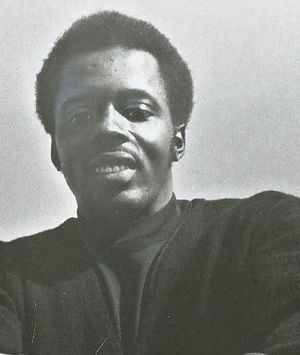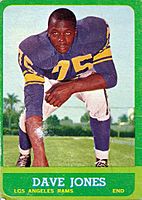Deacon Jones facts for kids

Jones in 1971
|
|||||||
| No. 75 | |||||||
|---|---|---|---|---|---|---|---|
| Position: | Defensive end | ||||||
| Personal information | |||||||
| Born: | December 9, 1938 Eatonville, Florida, U.S. |
||||||
| Died: | June 3, 2013 (aged 74) Anaheim Hills, California, U.S. |
||||||
| Height: | 6 ft 5 in (1.96 m) | ||||||
| Weight: | 272 lb (123 kg) | ||||||
| Career information | |||||||
| High school: | Hungerford (Eatonville, Florida) | ||||||
| College: | South Carolina State (1958) Mississippi Valley State (1960) |
||||||
| NFL Draft: | 1961 / Round: 14 / Pick: 186 | ||||||
| Career history | |||||||
|
|||||||
| Career highlights and awards | |||||||
|
|||||||
| Career NFL statistics | |||||||
|
|||||||
| Player stats at PFR | |||||||
|
Pro Football Hall of Fame
|
|||||||
David D. "Deacon" Jones (born December 9, 1938 – died June 3, 2013) was an amazing American football player. He played as a defensive end in the National Football League (NFL). Deacon Jones played for the Los Angeles Rams, San Diego Chargers, and the Washington Redskins. He was so good that he was put into the Pro Football Hall of Fame in 1980.
Jones was especially known for his "sacks." He even created the word "sack" for tackling the quarterback! People called him "the Secretary of Defense." Many think he was one of the best defensive players ever. The Los Angeles Times newspaper said he was the "most valuable Ram of all time." His old coach, George Allen, called him the "greatest defensive end of modern football."
Contents
Early Life and Challenges
Deacon Jones was born in Eatonville, Florida. He grew up in a house with ten family members. He went to Hungerford High School. There, he played football, baseball, and basketball. During high school, he had a tumor (a lump) in his leg. Doctors removed it with surgery.
When he was 14, Jones saw something unfair happen. This made him very determined. He later said that football gave him a way to deal with his feelings. It helped him become the strong player he was.
College Football Journey
Jones played college football for two different schools. In 1958, he played for South Carolina State University. Then, in 1960, he played for Mississippi Vocational College. This school is now called Mississippi Valley State University.
South Carolina State stopped his scholarship. This happened because he joined a protest during the Civil Rights Movement. An assistant coach from South Carolina State helped him. This coach was moving to Mississippi Vocational. He helped Jones and other African-American players get scholarships there. While playing, Jones and his teammates sometimes had to sleep in gyms. Motels would not let them stay because of their race.
Professional Football Career
Not many people knew about Jones when he was in college. There wasn't much TV coverage or scouting back then. The Los Angeles Rams found him almost by accident. They were looking at other players. But they saw Jones, a defensive player, running faster than the offensive players!
The Rams picked Jones in the 14th round of the 1961 NFL Draft. He quickly became a starter. He played defensive end alongside Merlin Olsen. Together, they formed a very strong defensive line. This line was called the "Fearsome Foursome." It included Jones, Olsen, Lamar Lundy, and Rosey Grier. Many people think they were one of the best defensive lines ever.
Jones was named an All-Pro player five years in a row. This was from 1965 to 1969. He also played in seven straight Pro Bowl games. He played in an eighth Pro Bowl in 1972 with the San Diego Chargers. In 1971, he hurt his foot. This made him miss some games.
In 1972, Jones was traded to the San Diego Chargers. He became their defensive captain. He led all defensive linemen in tackles. He finished his career with the Washington Redskins in 1974. In his last game, the Redskins let him kick an extra point. This was a special way to end his career. Jones was a very tough player. He missed only six games in 14 NFL seasons.
The "Sack" Master
Deacon Jones changed how the defensive end position was played. He is famous for creating the word "sacking the quarterback." He said it was like a city being "sacked" or attacked. It meant completely stopping the offense. He also said it was like putting offensive linemen in a bag and beating the bag.
What made Jones special was his speed. He could tackle players from one side of the field to the other. This was very unusual for his time. He also invented a move called the "head slap." He would quickly slap an opponent's helmet. This made them blink or close their eyes. That brief moment gave Jones an extra step to get past them. The "head slap" was so effective that the NFL later made it against the rules.
Unofficial records show that Jones had 173.5 sacks in his career. This would place him very high on the all-time sack list. In 1967, he had 21.5 sacks in just 14 games. The next year, he had 22 sacks in 14 games. The NFL did not officially record sacks until 1982. So, these numbers are unofficial.
| Unofficial Annual Sack Totals | ||
|---|---|---|
| Year | Sacks | Team |
| 1961 | 8 | Los Angeles Rams |
| 1962 | 12 | Los Angeles Rams |
| 1963 | 5.5 | Los Angeles Rams |
| 1964 | 22 | Los Angeles Rams |
| 1965 | 19 | Los Angeles Rams |
| 1966 | 18 | Los Angeles Rams |
| 1967 | 21.5 | Los Angeles Rams |
| 1968 | 22 | Los Angeles Rams |
| 1969 | 15 | Los Angeles Rams |
| 1970 | 12 | Los Angeles Rams |
| 1971 | 4.5 | Los Angeles Rams |
| 1972 | 6 | San Diego Chargers |
| 1973 | 5 | San Diego Chargers |
| 1974 | 3 | Washington Redskins |
(Source: Los Angeles Rams, San Diego Chargers and Washington Redskins Media Guides)
Life After Football
Deacon Jones did many interesting things after his football career.
Acting and Broadcasting
Jones became a television actor. He often appeared in small roles, called cameos. He was on shows like The Odd Couple and The Brady Bunch. He even played a guard in an episode of Bewitched. Later, he played himself on Wonder Woman. He also acted in movies like The Norseman and Heaven Can Wait. He even played a father figure to Alf on the show ALF.
Jones also worked as a color analyst for Rams radio broadcasts. He helped explain the games to listeners. He was good at predicting game outcomes. Before Super Bowl XXXII, he correctly predicted the Denver Broncos would win. He also guessed that Terrell Davis would be the MVP.
Business and Community Work
Jones worked for many big companies. These included the Miller Brewing Company and Haggar Clothing. He also worked with the NFL and Champion Products. He was a spokesman for their "Throwback" campaigns. He also helped with a health program for hypertension.
Deacon Jones cared a lot about his community. He visited U.S. military members in Iraq. In 1997, he started the Deacon Jones Foundation. This group helps young people. It offers programs for education, mentoring, and community service.
Bringing Football Back to Los Angeles
Jones was sad when the Rams moved to St. Louis in 1995. He always said he played for Los Angeles. He believed the St. Louis team was different. He worked hard to bring NFL football back to Los Angeles. He supported new stadium plans. The Rams finally returned to Los Angeles in 2016, after Jones had passed away.
Honors and Legacy
Deacon Jones received many honors for his amazing career. He was elected to the Pro Football Hall of Fame in 1980. This was his first year of being eligible. In 1994, he was named to the NFL's 75th Anniversary All-Time Team. The Sporting News ranked him number 13 on their list of 100 Greatest Football Players. Sports Illustrated called him the "Defensive End of the Century."
- 1980 – Elected to South Carolina Athletic Hall of Fame
- 1981 – Voted to the Central Florida Sports Hall of Fame
- 1983 – Elected to the Florida Sports Hall of Fame
- 1999 – Received the Gale Sayers Lifetime Spirit Achievement Award
- 1999 – Given "The Order of the Leather Helmet" by the NFL Alumni Organization, their highest honor
- 2001 – Won the NFL Alumni Spirit Award for community service
- 2005 – Received the Junior Seau Foundation "Legend of the Year Award"
- 2007 – Named to the Florida High School Association All-Century Team
- 2009 – His number 75 was retired by the Rams on September 27, 2009. This means no other Rams player will wear that number.
- 2013 – The NFL created the Deacon Jones Award. This award is given each year to the player with the most sacks. Robert Mathis was the first to win it.
Personal Life
Jones gave himself the nickname "Deacon." He said there were too many David Joneses in the phone book. He thought "Deacon" sounded religious and would be remembered.
His wife, Elizabeth, helps run the Deacon Jones Foundation. They lived in Anaheim Hills, California.
Deacon Jones was also a rhythm and blues singer. He sang with the band Nightshift, which later became the famous group War. He performed on TV shows like The Hollywood Palace and The Merv Griffin Show. The 1977 song "Deacon Blues" by Steely Dan was even named after him.
His Passing
Deacon Jones passed away on June 3, 2013, at the age of 74. He died at his home in Anaheim Hills, California. His death meant that Rosey Grier became the last living member of the famous Fearsome Foursome.
NFL Commissioner Roger Goodell said Jones was "an icon among the icons." Bruce Allen, whose father coached Jones, called him "one of the greatest players in NFL history." Many people, like sports writer Peter King, said Jones changed how defense was played in the NFL. He influenced many future stars. The NFL created the Deacon Jones Award to honor his legacy.



